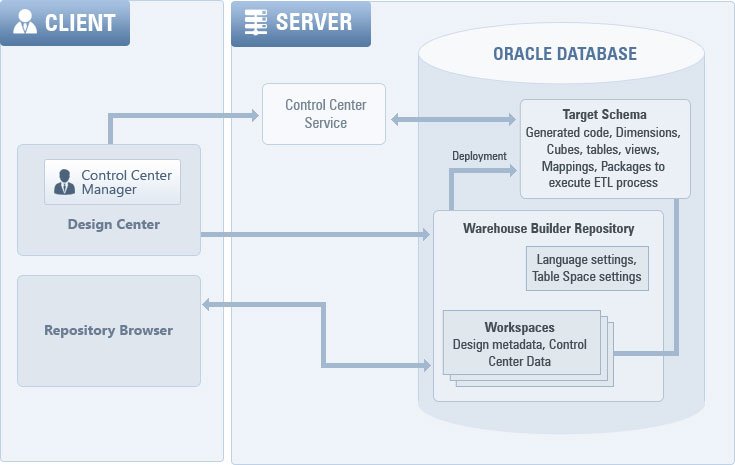
Architecture and elements of Oracle Warehouse Constructor

Design Center: It presents a visible consumer interface for designing, monitoring, scheduling, and deploying the ETL methods for extracting and remodeling information.
Control Center Manager: It is located in the design center and ETL is designed by customers from there. It is a full console, allowing customers to report all implementation elements within miles.
Target Schema: The target database helps a user to load records, artefacts and image maps into the centre of the layout. It contains OWB additions, including signatures, requiring that ETL mappings access the repository’s audit carrier programs. Creator of the database of the warehouse saves statistics for execution and deployment.
Not usually used in the function Object() { [native code] } of the factory, either an Oracle database or other database. A single warehouse builder repository can be correlated with multiple goal schemes.
Warehouse Builder Repository: Definitions of metadata in the architecture metadata are located in the archive, for all references, destinations, and processes. The Control Center Service & Control Center Manager also stores the data produced during operation. You can configure the storage directory by using Repository Wizard.
Workspaces: With Oracle Warehouse Designer, customers can build one or more working areas based on a hard and fast challenge for customers. For simpler and faster design, testing and distribution, separate workspaces are built. Repository assistant also promotes the maintenance and building of current workspaces.
Repository Browser: The GUI for tracking and reporting repositories is provided by a web interface. This registry explorer is useful for displaying metadata, inspecting runtime processes, generating documentation, conducting impact analysis, viewing and processing middle and layout-related statistics.
Control Center Service: This is the server region in which our data center and our supply locations are signed. The ETL logic we’ve created in the design center, such as mapping and system flow, is also supported and used.
Establish the consumer and archive of Oracle Design Center
We must first create an OWB customer to reach an OWB design center. We must build a new workshop, as well as a new user’s workplace and the warehouse creator repository for design, analysis, and production.
Accessing the Oracle Design Center
We wish to add repository connection information to log in as a repository user in the OWB design center. The architecture center consists of three parts: Link Explorer, Global Explorer, and Project Explorer.
- Challenge explorers are an area in which our design work is managed.
- We describe the techniques of metadata security in line with your implementing specifications in an international explorer panel.
- We can customize the source field, the centralized storage, files, utility, etc. in the link explorer.
Working with the transaction data in Flat File
Flat files in the factory are used as a library. A flat file storage module includes a folder containing any of the flat samples that we want to import into the warehouse.
A. Use a Flat File Sample Wizard to import flat file metadata
After we have created a flat record module, we can import flat file assets into the warehouse builder. In importing metadata objects, the Import Metadata wizard helps us. The Flat report pattern wizard is started when we use the import metadata wizard to import metadata of the new flat supply files. Test and log flat-file metadata using this wizard. This wizard shows the features of flat-file removal.
B. Create Oracle Data Source module and Oracle Import Data
For several other sources, like entirely relationship desk metadata based on Oracle, we may also create plugins. Data from the Oracle servers can also be imported.
Creating a Relational Target Warehouse
The design of a relatively focused storage facility in a store builder requires modeling relational schemes (from the third standard to the dimensional) that have high-quality documents into statistical storage facilities. A multidimensional framework can also be built using high-speed analytics.
Dynamic relational and dimensional modeling technology for Oracle Warehouse Builder. It makes it possible to design spatial supply gadgets, including tables, outside tables, angles, materialized views and sequences, and dimensionally targeted gadgets such as proportions and cubes.
The builder of the Oracle warehouse distinguishes between dimensional architecture and corporal building. We may choose from the simple operations for observable devices between a relational implementation and a multidimensional execution. The most basic reason is why equivalent and multi-dimensional designs of objects can be used in OLAP as a relational aim warehouse or multi-dimensional storage facility.
Setting a Warehouse Target Module in OWB
To create a target module for configuring and constructing our target warehouse, we want to use warehouse builders. We use the concept of metadata for target gadgets to construct target modules. The target user schema that belongs to any database-powered such as Oracle, Teradata, etc. should be mapped to the goal modules.
As a result, to physically maintain our target items in operation, we must first construct a target schema before we can establish a warehouse builder target module. As a result, by assigning the appropriate target database position, we would like to set the target scheme. We must first complete the following steps to configure our target warehouse module:
- Set up a target consumer and a target venue.
- Make a Target Module.




